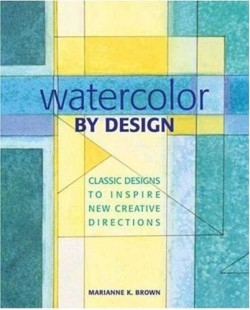Watercolor by Design
Classic Designs to Inspire New Creative Directions
A visually striking book, Watercolor by Design is a hardworking hands-on guide for watercolorists, yet its coffee table good looks and discussion of design principles offer inspiration to visual artists in every medium. Author and award-winning artist-teacher Marianne Brown serves as friendly mentor as she shares, artist-to-artist, practical insights from thirty years of experience.
According to the author, the concept of creativity “guides my overall approach…” Encouraging her artist readers, Brown advocates an active approach to creativity, “Dream up a new shape and present it in different ways.” The book explores practical opportunities to bring that creativity to life, with detailed step-by-step directions for creating twelve varied watercolor paintings, each of which illustrates a different principle of overall visual design.
Reinforcing the importance of planning the painting in advance, she suggests in an early tip, “When experimenting with space arrangements, decide on your plan and write yourself a note summarizing your decision…[to] keep you working in the right direction.”
Dramatic black-background spreads open each chapter, with a full page image on the left and white text reversing out of the black on the right, introducing the basic conversation about what’s covered in the chapter. Beginning with the basics, the book opens with four chapters that cover materials, fundamentals, preliminary drawing, and color review. The heart of the book focuses on “twelve basic design motifs to be used in planning innovative, creative, and personal arrangements of spaces, colors, and shapes in your paintings.”
Following a tightly organized, beautifully designed, and thoughtfully planned format, the book expands into twelve chapters each focusing on a single design motif. The twelve design chapters cover horizontal, vertical, pyramidal, floating, overall, cruciform, frame-in-frame, cantilevered, staggered, checkerboard, asymmetrical, and radial design. Consistent chapter layouts make it easy to focus on a single design principle and mine its depths.
Each chapter starts with a supplies list, then the author painstakingly unravels the entire process, benefiting both experienced and new artists. Starting with an initial drawing, then illustrating how she develops her palette of colors for the piece, the author explains how to transfer the drawing to watercolor paper. Seeing the piece in process, starting with the basic washes of color, the reader gets to watch the development as the artist adds paint, adjusts values, and adds finishing touches.
With Valley Barn, an illustration of the asymmetrical design motif in a realistic style, she advises in one of the many tips boxes, “Sometimes it’s fun to use a big, soft mop or hake brush for the beginning wash…It will lay down a freer, looser wash…” Artists can see the looser wash in the initial views of this piece. Although her palette preview features three primary colors, she notes, “you can see how many muted mixtures these bright pigments can produce, many of which will be more appropriate for my realistic outdoor scene than the unblended colors.”
The cover image, City Park, illustrates the cruciform (cross) design motif. Her explanation of the texturing in this abstract painting involves using salt to generate textural effects. She explains its effects, saying, “As the wash dries naturally, the salt moves the paint.” The tip box further advises, “… experimenting with all different kinds of salt.”
Showing the author’s adaptability, the book illustrates the frame-in-frame design motif with the author’s collage, Sunset Charade, as one of the step-by-step examples. Although not technically a watercolor painting, it gives artists permission to explore outside the boundaries of the watercolor medium. Even for collages, though, the artist starts with sketches to create a structure. It speaks to a deep well of experience to see three dramatically different types of images created by a single artist in this book.
At the end of each how-to section, there’s a full-page box of “Other Ideas to Consider.” She always advises her readers to “think outside the box,” with ideas and questions to help generate new approaches related to that motif.
Although all the step-by-step images are the author’s work, each chapter concludes with a visual gallery of other images, often including work from her students. Gallery images include insightful captions explaining techniques, paint colors used, and how the image addresses that particular design format. Abstract and nonobjective images share the page with realism, including landscapes, still lives, and portraits.
Inspiring and practical, this volume is highly recommended for watercolorists and artists in any medium exploring new creative directions and ways to enhance their design vocabulary. It’s a strong addition to libraries with visual arts how-to sections.
Disclosure: This article is not an endorsement, but a review. The publisher of this book provided free copies of the book to have their book reviewed by a professional reviewer. No fee was paid by the publisher for this review. Foreword Reviews only recommends books that we love. Foreword Magazine, Inc. is disclosing this in accordance with the Federal Trade Commission’s 16 CFR, Part 255.

